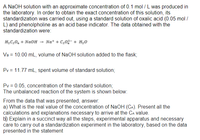
Chemistry
10th Edition
ISBN: 9781305957404
Author: Steven S. Zumdahl, Susan A. Zumdahl, Donald J. DeCoste
Publisher: Cengage Learning
expand_more
expand_more
format_list_bulleted
Question
H2C2O4 + NaOH ➙ Na+ +C2O42- + H2O

Transcribed Image Text:A NAOH solution with an approximate concentration of 0.1 mol / L was produced in
the laboratory. In order to obtain the exact concentration of this solution, its
standardization was carried out, using a standard solution of oxalic acid (0.05 mol /
L) and phenolpholine as an acid base indicator. The data obtained with the
standardization were:
HạC_0̟ + NaOH -
Na* + C,0;- + H20
Va = 10.00 mL, volume of NaOH solution added to the flask;
Pv = 11.77 mL, spent volume of standard solution;
Pv = 0.05, concentration of the standard solution;
The unbalanced reaction of the system is shown below:
From the data that was presented, answer:
a) What is the real value of the concentration of NaOH (CA). Present all the
calculations and explanations necessary to arrive at the CA value.
bl) Explain in a succinct way all the steps, experimental apparatus and necessary
care to carry out a standardization experiment in the laboratory, based on the data
presented in the statement
Expert Solution
This question has been solved!
Explore an expertly crafted, step-by-step solution for a thorough understanding of key concepts.
This is a popular solution
Trending nowThis is a popular solution!
Step by stepSolved in 3 steps with 4 images

Knowledge Booster
Learn more about
Need a deep-dive on the concept behind this application? Look no further. Learn more about this topic, chemistry and related others by exploring similar questions and additional content below.Similar questions
- How might the lack of a common nomenclature be a safety concern? Share a potential scenario in which a misunderstanding of key nomenclature could lead to a major disaster.arrow_forwardWhat two ionic compounds are dissolved in the filtrate after the suction filtration step What two compounds are being removed when you heat the solid CaCO; in the oven?arrow_forwardI need help with all of these, please hurry and be correct!arrow_forward
- hydrogen peroxide → water + oxygen List two physical / chemical properties for each compoundarrow_forwardWhich molecules are enantiomers? Which molecules are the same? (A). H Brarrow_forwardBromine (Br2₂) melts at 266 K and boils at 332 K. Which of the following is the best representation of bromine at 300 K? 。。。。 A A B с Darrow_forward
- Give the noble gas shorthand notation (ex: [He] 2s2 2p1) for Br Give the noble gas shorthand notation (ex: [He] 2s2 2p1) for Ca+2 Give the noble gas shorthand notation (ex: [He] 2s2 2p1) for Znarrow_forwardHow many grams of the 90% pure gold must a smith use with a 65% pure gold alloy to make 5000 grams of an alloy which will be 70% gold?arrow_forwardYou have a 11.5 mg sample of blood that contains various proteins. Hemoglobin is the only protein in the sample containing Fe. Hemoglobin contains 3.83% by mass of a compound called heme (C₃₄H₃₂FeN₄O₄, MW = 616.49 g/mol). You find that your 11.5 mg blood sample contains 34.9 micrograms of Fe. What is the mass percent of hemoglobin in your protein sample? -don't prematureley roundarrow_forward
arrow_back_ios
arrow_forward_ios
Recommended textbooks for you
 ChemistryChemistryISBN:9781305957404Author:Steven S. Zumdahl, Susan A. Zumdahl, Donald J. DeCostePublisher:Cengage Learning
ChemistryChemistryISBN:9781305957404Author:Steven S. Zumdahl, Susan A. Zumdahl, Donald J. DeCostePublisher:Cengage Learning ChemistryChemistryISBN:9781259911156Author:Raymond Chang Dr., Jason Overby ProfessorPublisher:McGraw-Hill Education
ChemistryChemistryISBN:9781259911156Author:Raymond Chang Dr., Jason Overby ProfessorPublisher:McGraw-Hill Education Principles of Instrumental AnalysisChemistryISBN:9781305577213Author:Douglas A. Skoog, F. James Holler, Stanley R. CrouchPublisher:Cengage Learning
Principles of Instrumental AnalysisChemistryISBN:9781305577213Author:Douglas A. Skoog, F. James Holler, Stanley R. CrouchPublisher:Cengage Learning Organic ChemistryChemistryISBN:9780078021558Author:Janice Gorzynski Smith Dr.Publisher:McGraw-Hill Education
Organic ChemistryChemistryISBN:9780078021558Author:Janice Gorzynski Smith Dr.Publisher:McGraw-Hill Education Chemistry: Principles and ReactionsChemistryISBN:9781305079373Author:William L. Masterton, Cecile N. HurleyPublisher:Cengage Learning
Chemistry: Principles and ReactionsChemistryISBN:9781305079373Author:William L. Masterton, Cecile N. HurleyPublisher:Cengage Learning Elementary Principles of Chemical Processes, Bind...ChemistryISBN:9781118431221Author:Richard M. Felder, Ronald W. Rousseau, Lisa G. BullardPublisher:WILEY
Elementary Principles of Chemical Processes, Bind...ChemistryISBN:9781118431221Author:Richard M. Felder, Ronald W. Rousseau, Lisa G. BullardPublisher:WILEY

Chemistry
Chemistry
ISBN:9781305957404
Author:Steven S. Zumdahl, Susan A. Zumdahl, Donald J. DeCoste
Publisher:Cengage Learning

Chemistry
Chemistry
ISBN:9781259911156
Author:Raymond Chang Dr., Jason Overby Professor
Publisher:McGraw-Hill Education

Principles of Instrumental Analysis
Chemistry
ISBN:9781305577213
Author:Douglas A. Skoog, F. James Holler, Stanley R. Crouch
Publisher:Cengage Learning

Organic Chemistry
Chemistry
ISBN:9780078021558
Author:Janice Gorzynski Smith Dr.
Publisher:McGraw-Hill Education

Chemistry: Principles and Reactions
Chemistry
ISBN:9781305079373
Author:William L. Masterton, Cecile N. Hurley
Publisher:Cengage Learning

Elementary Principles of Chemical Processes, Bind...
Chemistry
ISBN:9781118431221
Author:Richard M. Felder, Ronald W. Rousseau, Lisa G. Bullard
Publisher:WILEY